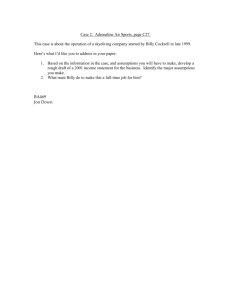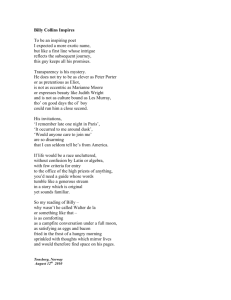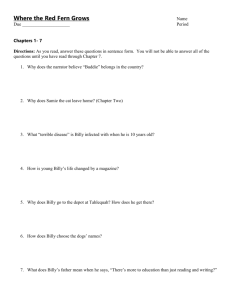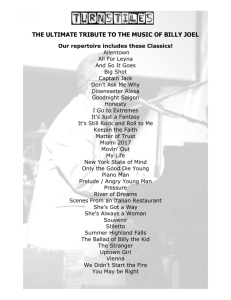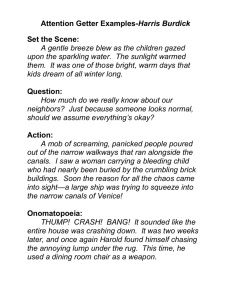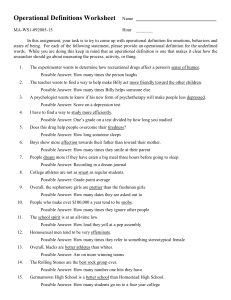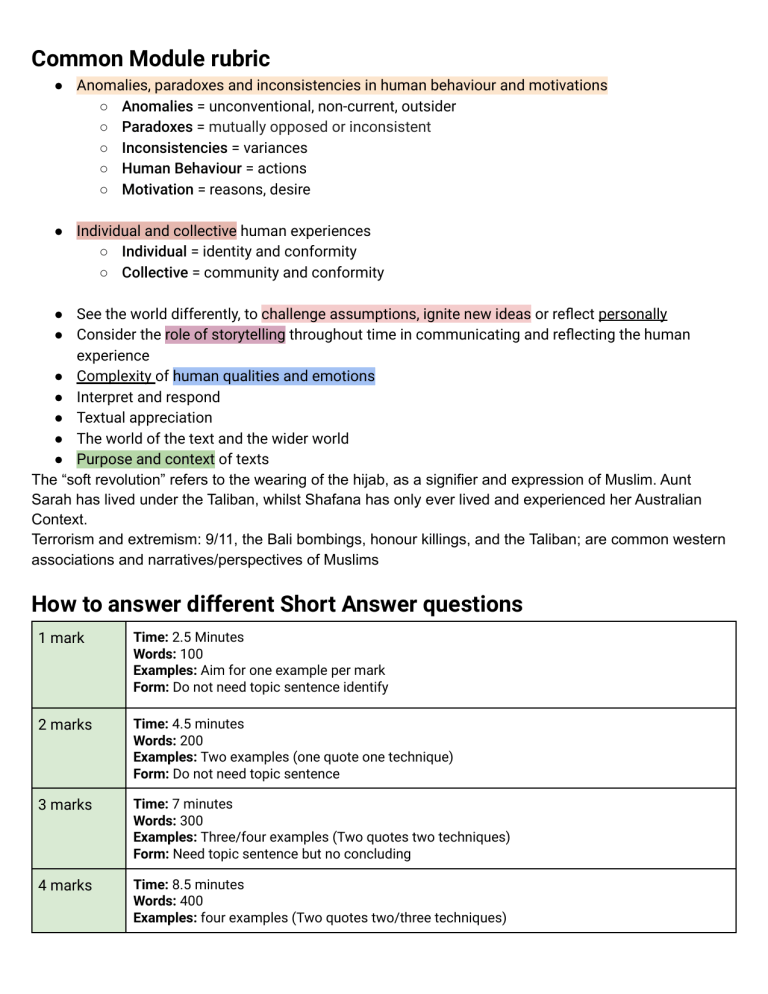
Common Module rubric
● Anomalies, paradoxes and inconsistencies in human behaviour and motivations
○ Anomalies = unconventional, non-current, outsider
○ Paradoxes = mutually opposed or inconsistent
○ Inconsistencies = variances
○ Human Behaviour = actions
○ Motivation = reasons, desire
● Individual and collective human experiences
○ Individual = identity and conformity
○ Collective = community and conformity
● See the world differently, to challenge assumptions, ignite new ideas or reflect personally
● Consider the role of storytelling throughout time in communicating and reflecting the human
experience
● Complexity of human qualities and emotions
● Interpret and respond
● Textual appreciation
● The world of the text and the wider world
● Purpose and context of texts
The “soft revolution” refers to the wearing of the hijab, as a signifier and expression of Muslim. Aunt
Sarah has lived under the Taliban, whilst Shafana has only ever lived and experienced her Australian
Context.
Terrorism and extremism: 9/11, the Bali bombings, honour killings, and the Taliban; are common western
associations and narratives/perspectives of Muslims
How to answer different Short Answer questions
1 mark
Time: 2.5 Minutes
Words: 100
Examples: Aim for one example per mark
Form: Do not need topic sentence identify
2 marks
Time: 4.5 minutes
Words: 200
Examples: Two examples (one quote one technique)
Form: Do not need topic sentence
3 marks
Time: 7 minutes
Words: 300
Examples: Three/four examples (Two quotes two techniques)
Form: Need topic sentence but no concluding
4 marks
Time: 8.5 minutes
Words: 400
Examples: four examples (Two quotes two/three techniques)
Form: Need topic sentence and concluding
5 marks
Time: 10 minutes
Words: 500
Examples: five examples (Two/three quotes two/three techniques)
Form: Need topic sentence/thesis and concluding
If you need to write about two texts divide into paragraphs
6 marks
Time: 12 minutes
Words: 600
Examples: six examples (Two/three quotes two/three techniques)
Form: Need topic sentence/thesis and concluding
If you need to write about two texts divide into paragraphs
7 marks
Time: 15 minutes
Words: 700
Examples: six examples (three quotes three techniques)
Form: Need topic sentence/thesis and concluding
If you need to write about two texts divide into paragraphs
SHORT ANSWER
General rules:
1. What is the human experience?
2. What is the message about that experience?
3. How does the evidence prove the point?
KEY HUMAN EXPERIENCES
LIFE
-
Temporality of life
Coming of age
Mortality
Death reshapes perspective
Beauty of life (birth)
Nihilism (life has no meaning)
Moral Guidance and Religion
SOCIETY
-
Diversity and race (we are all equal)
Feminism (gender equality)
Materialism (lifestyle)
Ageism (not adapting to society)
Power of nature
Identity
Acceptance
COMPLEX
EMOTIONS
MILESTONES
-
Love
Resilience (grief and loss)
Optimism
Fear (resistance to change)
Perspective and meaning
Power and ambition
-
Returning home
Marriage
Death of a loved one
Work
Journeys (leaving home)
TECHNIQUES
Visual techniques:
Technique
Effect
Contrast
Interest, excitement or drama
Framing
disorrient audiences or suggest relationships
Salience
Draws your eyes
Vectors
Gives the image movement
Body language
Feelings or personality
Tone (tint or shade)
Creates the tone
Hue (colour)
Feelings e.g. red = angry
depth
Sense of scale or proportion
Space (empty parts)
Small space = chaotic, big space = loneliness
Language techniques:
Technique
Effect
Emotive language
Insights reader emotions
alliteration
Unifying feature to create tone
anaphora
Reinforce an idea
logos
Uses logical reasoning
hyperbole
Accentuate thoughts or ideas
juxtaposition
Layering of images for dramatic effect
onomatopoeia
Adds excitement and interest
tone
Covey the way an author feels
Pathetic Fallacy
Enjambment
Encourages flow
Anadiplosis
Reinforce or present the duality of an idea
Repetition
Reinforces an idea (too much could be cynical)
Allegory
Double meaning
personification
Gives a voice to the object increasing its power
Ellipsis (...)
More to be said...tone of contemplation...etc.
Truncated
Constrained...structured...finality.
metaphor
motif
paradox
Represents illogicality or truths
Sibilance (s)
Sinister or sensuous tone
Simile (like)
Hypophora
Ask a question and immediately answer it.
Conduplication
“Prepare a face to meet the faces.”
COMMON MODULE
BILLY ELLIOT NOTES
Context:
This is a film that examines what motivates us as human beings. Some people are motivated by an
intrinsic desire to break the mould of their lifestyle and pursue their dreams in order to strive for
something better, to find fulfilment and happiness. BREAKING THE MOULD OF SOCIETY
Setting:
● 1984 - 1985 County Durham, England.
- Mining strikes
- Poverty
- Working class
- Masculine stereotypes
- Dominated by social norms
●
●
●
●
STRIKES - working class aspiration for better working conditions.
BOXING HALL - melding of the upper middle class world of ballet and the working class.
CROSSING THE RIVER - track towards upward social mobility and escaping social restraints.
LONDON - symbol of power and authority.
Human Experiences:
● Overcoming adversity
● Pursuit of dreams and happiness
● Search for identity
● Acceptance
Characters:
Billy Elliot
Billy is the main protagonist in the film who struggles with internalised
conflict and interpersonal challenges as he faces his love for dance and the
male dominated economic mining industry in his small town. He turns to
dance to escape the imminent expectations and pressures to follow in the
footsteps of his father and brother.
Jackie Elliot
Jackie struggles greatly with the loss of his wife and having to take care of
his family on his own. He experiences this pressure further through loss or
his job at the mines struggling to provide for his family through the holidays.
Jackie also experiences a similar internalised conflict as Billy as he must
choose between giving up on Billy and his passion and thereby losing the
possibility or a bond between them or becoming a scab – a miner who
worked during the strike rather than protesting with his co-workers and
eldest son Tony.
Tony Elliot
Tony is fuelled by all the adversity he has experienced in his life. The loss of
his mother and job causes his character to be hurt and angry at the world.
Mrs. Wilkinson
Ballet teacher who introduces Billy to the Royal Ballet School. Unfulfilled in
her marriage, her husband doesn’t have a job. Her daughter is the same age
as Billy and he speaks to her about ballet.
Micheal Caffrey
Accepts Billy from the beginning or the film. Introduces Billy to
‘cross-dressing ’ as he learns that Michael as seen is dad do it which
infuences im. Billy can confide in Michael as he isn't afraid to talk about is
passion wit im and e becomes his closest friend.
Collective/Individual Experiences:
The paradoxical nature of human motivations can arise from the principles of collective identity which
cause characteris to recognise the need to express their individuality. This is paradoxical because the
establishment of one’s identity may come in conflict with social pressures demanding individuals fall into
the social construct of masculinity ideals. They suggest that an individual’s experiences are dependent
on the collective viewpoint.
Paradox
Inconsistency
Anomaly
Motivations
● Billy’s actions and desires are paradoxical to his context
● Family is supportive and loving yet destructive
● Jackie empowers to give agency to his son whilst also losing agency
● Ballet class in the same place as boxing
● Jackie’s decision to return to mining during the strike is
incompatible with his union loyalties
● Billy’s desire to assert his identity as a ballet dancer
● Commitment/ Defiance
How to Write an Introduction:
● Address question
● State text type
- Film
● State the director
- Stephan Daldry
● State year the film was released
- 2000
● One sentence on big picture context
- Billy Elliot is about a young boy who finds his passion for dance. The film is set in Northern
England in the mid-80s and explores gender stereotypes, different social classes, the 1984
miner's strike and the use of police violence.
● Why the text had an impact on the audience
-
gave the audience insight into the life of a boy chasing his dreams, whilst gaining
acceptance from his family.
● What will the essay examine
How to Write a Body Paragraph:
POINT
EVIDENCE
TECHNIQUE
Topic sentence/thesis statement, where you state the idea/argument that you are going to
extend upon.
Quote/scene taken from text that relates to the topic sentence.
language /visual technique used by the composer in your specific example.
ANALYSIS
Extend in detail on how the technique communicates a particular idea to the audience.
EVIDENCE
Quote/scene taken from text that relates to the topic sentence.
TECHNIQUE
ANALYSIS
LINK
language /visual technique used by the composer in your specific example.
Extend in detail on how the technique communicates a particular idea to the audience.
Concluding sentence that links the analysis back to the provided question.
Paragraph Topics:
1. Pursuit of dreams
2. Defying gender stereotypes
3. Achievement and triumph
4. Social constructs and stereotypes
5. Pursuit and acceptance
6. Dysfunctional family
7. Anguish due to unacceptance
Quote Bank:
EXAMPLE
st Scene, where billy is
mping and floating on the
d
ots and ballet shoes
ing next to each other
TECHNIQUE
ANALYSIS
Slow motion, tightly
framed shot
The shots provide a dreamy, surreal aesthetic. The wall
Billy is exaggerated in scale and is not representative o
space and time but rather shows how Billy is feeling in
moment.
Juxtaposition,
symbolism
The contrast between the two shoes shows the differen
masculinity and femininity and how Billy must choose a
ckie Breaking the family
no
Symbolism
The piano was one of the only items that is known to be
to Billy's mother. When Jackie destroyed it, it shows har
and a need for validation to use it for firewood.
allet is for girls, not lads,
Emotion, tone
s do boxing, football or
estling, not friggin ballet” ckie
Shows pre-existing gender difficulties faced by Billy's
transition and the lack of support from his family. This
particular scene also illustrates Jackie's frustration and
towards Billy’s ballet, supported by the tone used from t
character. This also shows how arrogant and narrow m
society was in the mid 80s.
s Wilkinson takes billy
t for a drive to the lake
Juxtaposition,
foreshadowing,
extreme wide-shot,
setting, link to the
modern world
The machinery in the background is juxtaposed against
natural environment, which Daldry demonstrated throug
extreme camera shots, which underscores an importan
tension between the industry, capitalism and beauty. Th
scene takes place at a lake, thus foreshadowing Billy's fi
performance of ‘Swan Lake’, which also recontextualize
story and connects it with the modern world.
ckie’s transition after he
es Billy dance
Juxtaposition, low
angle shots, framing
and composition,
visual imagery,
transitioning
Visual techniques are used to show the audience a glim
Jackie's transformation, as he learns to accept his son.
Jackie is looking to sell jewellery and goes to the door t
so, Daldry uses framing and composition to suggest his
internal conflict. The mining strike donation is placed
specifically next to the jewellery store, and he has to de
which side to align with. Furthermore when he travels w
Billy to the ballet school, he is clearly uncomfortable,
demonstrated by shots of him lingering outside the aud
room. This elegant, clean setting of the ballet school is
juxtaposed by the grubby blackened coal fields suggest
large tension between the different social classes.
MODULE B
CURIOUS INCIDENT OF THE DOG IN THE NIGHT TIME NOTES
Rubric Summary:
● Develop an informed understanding, knowledge and appreciation of a substantial text.
● Explore information, ideas, attitudes and values that are communicated in and through the text and
examine and reflect on the ways in which the content, form and language of the text have been
composed and assembled.
● Engage in extensive exploration and interpretation of the text and the ways the composer portrays
people, ideas and events in the text.
Rubric Concepts/Key Terms:
● Perspective, Point of View, Style
○ Perspective = How one sees and experiences things, helps to challenge, confirm or modify
personal beliefs and values through alternative views.
○ Point of View = The narrator or character's view which informs the reader, the composer can
choose the lens for the reader aka the narrative voice.
○ Style = How the composer communicates the ideas, includes a number of language
techniques combined to affect the audience and deepen the understanding of the chosen
emotion and idea.
Characters:
Possible Themes for Question:
● Difficulties with comprehending the world and others
● Logical thinking and Intellectual abilities
● The desire to have control
● Isolation / alienation
● Discomfort with lies
● The impact of difference on family dynamics
● Human Connection
How to Write an Introduction:
● Address question
● State text title (abbreviation in brackets)
○ Curious incident of the dog in the night time (Curious)
● State text type
○ Novel
● State author
○ Mark Haddon
● State year of publication
○ 2003
● One sentence on big picture context
○ Curious is crime fiction novel that follows the perspective of a neurodiverse young boy
Christopher Boone, who take the audience on a journey of uncovering the truth of the
ovel”
murder of his nabours dog. As the story progresses , the audience learns that the story is
really about uncovering the truth of his mother.
● What will the essay examine
○
● Why the text had an impact on the audience
○ gave inside into the daily life of a neurodiverse person
Body Paragraph topics:
● Unique narrative voice
● Postmodern approach to storytelling
- Inter-chapters - Pastiche of genres - Metafiction - Bricolage of text types ● Subjectivity
● Truth and trust
● Logic
● Family relationships
Quote Bank:
TECHNIQUE
Simple sentence
structure, first person
narration, authorial
intrusion
THEME
Difficulties with
comprehending the
world and others
Postmodern approach pastiche of genres
ANALYSIS
Christopher directly addresses the audience to invite t
into his head and into his point of view. Inviting the rea
world creates a connection and bond with the protago
allowing the audience to extend the understanding of
experiences the world.
Christopher introduces the crime genre, allowing the a
gain a valuable interest in the novel due to its unfamili
ture
ppy”
Emotions - visual
representation
Difficulties with
comprehending the
world and others
The use of emoticons within the novel allows the audi
interpret the world that Christopher experiences direct
point of view. This allows for a deeper understanding o
Christopher and how he perceives others.
e
d
Symbolism
Isolation
As the rat is in isolation it reflects and symbolises the
which Christopher is feeling as he lives his life in an em
isolation.
g
g, but
o we
hat
Pathos, monotonic tone
Human connection
Family dynamic
Provides insight into Christopher’s experiences of loss
human connection. Explores Christopher’s struggle wi
deepening both Ed and Christopher’s character and th
relationship.
MODULE C
CREATIVE WRITING NOTES
Imaginative Writing:
Imaginative texts represent ideas, feelings and mental images in words or visual images. An imaginative
text might use metaphors to translate ideas and feelings into a form that can be communicated
effectively to the audience.
Narrative Tips:
● Clear purpose - what emotions you want your reader to feel
● Most imaginative texts can be divided into the following categories
○ A hero goes on a journey
○ A stranger/strange object arrives
● Pick a universal idea and reflect on what you want to say about this idea.
○ Power
○ Greed
○ Struggle
○ Overcoming impossible odds
○ Growing up
○ love
○ Inevitability of change
○ mortality
● Draw upon the knowledge from other texts
Story Ideas:
● A poor young boy comes into an unexpected fortune
● A long journey is interrupted by a disaster
REFLECTIVE WRITING NOTES
Introduction:
● identify your text’s purpose and target audience clearly.
● Provide your texts’ details and explain why you chose to focus on that aspect of the unit and your
chosen
● genre.
● In the introduction give the details of the main inspirational text you will feature.
Body Paragraphs:
PURPOSE
Introduce an aspect of your purpose: a concept (idea) and/or style
and explain how it contributes to your text’s purpose and relates to
the intended audience. Tie this to the question or stimulus.
INSPIRATIONS
Where did the idea come from? What text, either in class or out,
helped you to make your concept and style choices? Explain how
it has inspired/informed/shaped your writing?
EXAMPLES
Provide an analysed example of the idea from the text which has
influenced you and explain how it links to your own writing.
CLOSE ANALYSIS
How have you utilised this idea (concept, style, feature or form) in
your text? Explain how it has inspired your text and analyse how it
is shown in your text.
EVALUATION
How successful/effective have you been in implementing this
aspect in your writing in order to achieve your purpose and engage
your audience?
Conclusion:
● Conclude your reflective piece by summing up the success of achieving your purpose, referring to
what you’ve learnt about the writing process, and with reference to your target audience.
PERSUASIVE WRITING NOTES
What a Persuasive Text is:
A persuasive text is any text where the main purpose is to present a point of view and seeks to persuade
a reader. A persuasive text can be an argument, exposition, discussion, review or even an advertisement.
APPEAL TO EMOTIONS (PATHOS) Persuasion often succeeds by the careful and considered use of
emotion - especially showing how passionate you feel for your point of view.
APPEAL TO REASON (LOGOS) Most people believe themselves to be reasonable, so appealing to a
person's sense of reason is the most effective means of convincing them to change their way of thinking
('If we don't do this... then... ). APPEAL TO
CHARACTER (ETHOS) We all share certain common ideas of what is just and fair! Appealing your
audience’s sense of what is right and fair can be a powerful persuasive device, e.g. 'Like you, I share a
sense of horror and repulsion at what is happening
How to Make an Effective Point:
1. Introduce it
2. Explain it
3. Justify it
Words to use:
● High modality words
● Emotive
● Formal voice
● Repetition
● Connectives
● Present tense
DISCURSIVE WRITING NOTES
MODULE A
…
Zane king
Zane king
